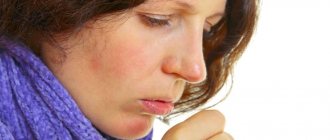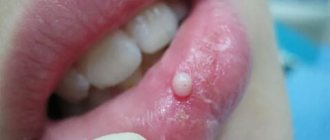What is phlegm needed for?
Sputum is the secretion of the tracheobronchial tree separated by expectoration mixed with saliva. Its purpose is to remove dust and microbes from the bronchi that enter the body when inhaled. Additionally, this mucus contains immune cells that help fight germs.
Inside, the bronchi are covered with epithelium with cilia, which, when moving, help clear the airways of mucus. In a healthy body, the amount of sputum produced is approximately 100 ml per day. In this case, it is swallowed unnoticed by the person and does not lead to any unpleasant sensations. If pathological processes occur in the body, then the amount of mucus produced sometimes increases to 1500 ml per day. Moreover, each disease is accompanied by sputum of a certain color.
Where can I buy
Causes of mucus accumulation in the throat in adults
The mucus in the nose serves as a kind of shield that protects the mucous membrane from various types of damage. This could be dust, dirt and other small particles. This mucus can also be thick, but in moderation. It envelops the mucous membrane and prevents harmful substances from contacting it.
But everything is not always so wonderful, and often a large accumulation of snot is a cause for concern, as it is a symptom of a certain disease. In order to accurately understand the reason for the accumulation of mucus, as well as why mucus flows from the nasopharynx into the throat, often with bitter-tasting blood, it is necessary to consider its types.
By the color of mucus accumulation in the nasopharynx, the disease can be identified and a diagnosis made.
This article describes cough medicines for pregnant women.
Collection of white snot
When natural-colored mucus accumulates in the nasopharynx of an adult, sometimes in the morning, doctors unanimously confirm the presence of a cold. When a runny nose occurs due to hypothermia, mucus first comes out with a liquid consistency, and only then becomes viscous. At the initial stage of a cold, which is characterized by a runny nose, thick, whitish mucus is released. If the disease is advanced or the treatment was incorrect, the snot becomes yellow or even green.
The most unpleasant thing is when the mucus is not swallowed and flows along the back wall. There is a feeling that something is constantly tickling in the throat, while expectoration is impossible.
At the provided link you can find information about how to treat purulent sore throat in adults.
Viscous mucus may indicate that an allergic reaction has started in the nasopharynx. It can be caused by irritants entering the nasal cavity. This phenomenon is considered normal, since the allergen affects the mucous membrane. As a result, it begins to actively produce mucin proteins, thanks to which it is possible to create a kind of protective shield.
Where does the green clot come from?
If, while blowing your nose, you see green snot coming out of your nose, sometimes in the form of a lump, then this is a clear sign of chronic ailments in the body (pneumonia or bronchi). The body actively fights infections, as a result of which the immune system secretes a special component that gives the mucus its color. Very often, green snot indicates the presence of advanced rhinitis, as well as the body’s successful fight against the virus. During such a fight, all pathogenic microorganisms die, and the body returns to its usual rhythm. Read about the treatment of green snot in children here.
Types of sputum
Depending on the causes, the cough can be dry or wet. Of course, the latter type is easier for humans to tolerate and responds better to treatment. Thanks to the release of mucus from the respiratory tract, recovery occurs faster. But in this case, it is necessary to carefully monitor the characteristics of the sputum, its color and consistency, in order to detect the pathological process in time and begin appropriate therapy. Otherwise, seemingly harmless symptoms can lead to serious consequences. The following types of sputum are distinguished:
- mucous membrane (whitish or colorless);
- serous;
- purulent (yellow-green);
- mucopurulent;
- bloody (yellowish-transparent with blood impurities).
Of the listed types, only mucous sputum does not pose any particular danger. It occurs in diseases of the respiratory tract accompanied by catarrhal inflammation (initial manifestations of an acute inflammatory process or a chronic inflammatory process in remission). The greatest risk to the patient’s health is indicated by purulent and mucopurulent sputum, which is formed in such serious diseases as bronchitis, pneumonia, bronchiectasis, tuberculosis, abscess and gangrene of the lung. Only a doctor can determine the cause of a particular symptom, so you should not self-medicate and cause the disease to worsen. In addition, the color of sputum largely depends on a person’s lifestyle. For example, heavy smokers may produce sputum of different colors: from white to brown. This phenomenon indicates the need to take care of lung health.
Why might blood appear in snot?
A small amount of blood in the snot is very frightening for patients. Most often, it is not anything serious and can appear due to the following reasons:
- frequent use of vasoconstrictor drops for a runny nose causes increased fragility of blood vessels, which is why snot appears in the throat with blood;
- Some types of cold viruses make the vascular wall weak and small vessels easily rupture;
- a person blows his nose and coughs up this mucus so hard that small blood vessels break due to excessive effort;
- taking certain medications (anticoagulants) thins the blood and increases the risk of nosebleeds;
- the patient likes to pick his nose with his finger and other objects to remove crusts, and at the same time injures the blood vessels.
If streaks of blood appear in the discharge, then do not immediately panic. The danger comes from massive bleeding from the nasopharynx, which a person cannot stop on his own.
If you notice blood in the mucus, you need to bring this to the attention of your doctor so as not to miss a serious illness.
Principles of treatment of cough with sputum
If a person is suffering from a cough with sputum, it is recommended to provide plenty of fluids; it is possible to use drugs or herbal remedies that have an expectorant, anti-inflammatory, enveloping and bronchodilator effect. There are several groups of medications that are prescribed to relieve the symptoms of wet cough:
- expectorants . They are prescribed for viscous sputum to facilitate the process of its removal from the respiratory tract. A similar effect is achieved through reflex stimulation of the glands located in the bronchial mucosa. When using these drugs, the amount of mucus may increase due to the dilution of sputum;
- mucoregulating agents. They help reduce the secretion of sputum and, like expectorants, allow it to be removed from the body. In case of exacerbation of bronchial asthma, the use of these drugs is contraindicated, therefore, before taking, you should consult with your doctor;
- mucolytic agents. They improve the removal of sputum by stabilizing the release of bronchial secretions. These drugs are usually prescribed for tracheitis, bronchitis, pneumonia and other diseases;
- antihistamines. They are prescribed if the cough is a consequence of allergies. They help alleviate the consequences of the body's reaction to certain irritants. If you are bothered by a sore throat, sputum of unusual color and consistency, cough, fever and other unpleasant symptoms, you should consult a doctor. Such manifestations are a consequence of a number of diseases, so consultation with a specialist is necessary to make a diagnosis and select therapy. This will help avoid complications and start treatment in a timely manner.
Treatment methods
There are several methods to eliminate posterior rhinitis: medication treatment, the use of folk remedies, rinsing the sinuses, and inhalation. Complex therapy is often prescribed, including two or more methods.
Drug therapy
If a lump in the nasopharynx that has existed for a long time does not clear up, you need to contact an otolaryngologist to prescribe treatment. For this diagnosis the following is used:
- Ingalipt, Orasept, Lugol belong to the group of antiseptics with an anti-inflammatory effect, have no contraindications, are sprayed onto the mucous membrane of the throat, thus removing swelling. Use medications after each meal.
- Lazolvan in the form of a spray is a mucolytic and is used three times a day. In the form of syrup, children over 12 years old, 5 milligrams three times a day. The form of tablets or wafers is approved for use from 6 years of age, the dosage is determined by the doctor.
- Brocholitin syrup is diluted in cold water (the proportions are indicated in the instructions for use) and taken after meals (3-4 times). The drug is not indicated during pregnancy and lactation;
- Mucaltin is a mucolytic with an expectorant effect, contraindicated with a diagnosis of gastric ulcer. The tablet is diluted in water and taken three times a day.
- Treatment of viscous snot in the nasopharynx in an adult, if it is caused by bacteria, is carried out with the help of antibacterial drugs: Solutab, Co-trimoxazole, Flemoxin. The latter, has a lemon taste, is not contraindicated for women during pregnancy.
- Amoxiclav is also an antibacterial drug, taken three times a day, one tablet dissolved in water.
- Arbidol is contraindicated in children under two years of age; it belongs to the group of antiviral drugs; it is used for acute respiratory diseases and influenza, 2/10 grams three times a day, the course of treatment is from 5 to 14 days.
If the snot in the nasopharynx is the result of an allergic reaction, Suprastin or Loratadine is prescribed.
Folk remedies
Traditional medicine is used in combination with drug treatment, they enhance the effect of the latter. Several recommendations on how to get rid of snot in the nasopharynx using traditional medicine:
- Inhalation is done over raspberry branches steamed in water. To do this, you need to take 100 grams of dried raspberry branches or 200 grams of fresh ones, cut into about five centimeters. Pour in a liter of cold water and bring to a boil. When the water boils, inhale the steam, covering your head with a towel. Monitor the evaporation temperature. High temperature steam may damage the respiratory tract.
- Inhalation is used if snot is coughed up through the mouth. The principle of the procedure is the same as in the previous method. The composition is made on the basis of sage, chamomile and calendula, mixed in equal parts (2 tablespoons). The mixture is poured with a liter of water. When the broth has reached boiling point, add a spoonful of honey.
- For instillation into the nasal passages, an infusion of peeled aloe leaf and honey is made. To do this, the middle leaf of the agave is finely chopped, the juice is squeezed out and added to the solution (a spoonful of honey dissolved in 50 grams of water).
- Gargling with pepper tincture (adults only). Crushed hot pepper, pour boiling water (0.5 liters) and infuse for 24 hours.
In folk medicine, a composition of calendula and honey is provided for internal use. To do this, take equal parts of honey and calendula petals, mix, and take 0.5 tablespoon orally three times a day.
Washing
The procedure is available for use at home. By washing away excess secretions, bacteria and viruses are removed and drying out of the mucous membrane is eliminated. Solutions are used if mucus with a consistency such as thick snot is coughed up:
- saline solution (two tablespoons of salt per liter of water);
- solution using soda (a spoon of baking soda per 0.5 liters of water);
- manganese solution (the liquid should be light pink). Manganese that is not completely dissolved in water can cause a burn to the mucous membrane.
- Furacilin solution is prepared according to the instructions for the drug;
- A decoction of chamomile and sage (two tablespoons of chamomile + two tablespoons of sage) is brewed in a liter of water.
You can rinse the nasopharynx using a rubber bulb with a tip. Pouring the solution one at a time into the nasal passages. It is advisable to carry out the procedure in the morning after sleep, when a significant amount of mucus accumulates during the night.
Causes of productive cough
A cough is called productive,
accompanied by the release of mucus. White sputum, as well as other shades, is expectorated. A productive cough occurs when:
- acute upper respiratory tract diseases;
- chronic lung diseases;
- inflammation in the nasopharynx, which is accompanied by accumulation of mucus;
- allergies;
- presence of an addiction: smoking;
- reflux (penetration of stomach contents into the esophagus).
There are many diseases that begin their development with a nonproductive (dry) cough. During therapeutic measures, it becomes productive (white sputum is coughed up).
White sputum when coughing cleanses the respiratory system of pathogenic microbes.
If the pathological condition lasts more than three days, you need to see a doctor.










